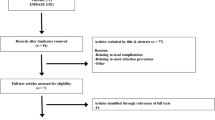Abstract
Purpose
Synthetic mesh for herniorrhaphy has been placed under critical observation regarding the potential association of mesh placement and the subsequent development of autoimmune diseases. We sought to evaluate whether there is a link between synthetic polypropylene mesh repairs and the subsequent development of systemic/autoimmune disorders (SAID).
Study design
Adult men undergoing hernia repair with mesh between January 2008 and December 2009 in New York State were identified using International Classification of Diseases, Ninth Revision, Modification procedure codes and Current Procedural Terminology Coding System, Fourth Edition codes. A control cohort of men undergoing colonoscopy was created with whom to compare outcomes.
Results
A total of 29,712 patients underwent hernia repair between January 2008 and December 2009. In the control cohort, 79,265 patients underwent colonoscopy. During the entire follow-up, 475 patients undergoing hernia repair and 1305 patients in the control cohort were diagnosed with autoimmune disease. When patients were matched based on demographics, comorbidities and procedure date, hernia repair was not associated with an increased risk of developing autoimmune disease over the entire follow-up time period. 1.6% of those in the hernia group vs. 1.7% of those in the colonoscopy group developed SAID [risk ratio (95% CI): hernia vs. colonoscopy 0.93(0.79–1.09)]. No association between mesh surgery and increased risks of SAID was found at any of the specified time points (6 months, 1 year, and 2-year follow-up).
Conclusions
Mesh-based hernia repair was not associated with the development of autoimmune diseases compared to those undergoing routine screening colonoscopy.

Similar content being viewed by others
References
Rutkow IM (2003) Demographic and socioeconomic aspects of hernia repair in the United States in 2003. Surg Clin North Am 83(5):1045–1051 (v-vi)
Gandhi D, Marcin S, Xin Z, Asha B, Kaswala D, Zamir B (2011) Chronic abdominal pain secondary to mesh erosion into cecum following incisional hernia repair: a case report and literature review. Ann Gastroenterol 24(4):321–324
FDA (2016) Hernia surgical mesh implants. http://www.fda.gov/MedicalDevices/ProductsandMedicalProcedures/ImplantsandProsthetics/HerniaSurgicalMesh/default.htm. Accessed 22 Nov 2016
Bilsel Y, Abci I (2012) The search for ideal hernia repair; mesh materials and types. Int J Surg 10(6):317–321
FDA (2014) Safety communications—surgical mesh: FDA safety communication. http://www.fda.gov/MedicalDevices/Safety/AlertsandNotices/ucm142636.htm. Accessed 22 Nov 2016
Akre J (2014) Autoimmune diseases and surgical mesh—causation or correlation? Available from: http://meshmedicaldevicenewsdesk.com/autoimmune-diseases-and-surgical-mesh-causation-or-correlation
Ostergard DR (2010) Polypropylene vaginal mesh grafts in gynecology. Obstet Gynecol 116(4):962–966
Clave A et al (2010) Polypropylene as a reinforcement in pelvic surgery is not inert: comparative analysis of 100 explants. Int Urogynecol J 21(3):261–270
Health N.Y.S.D.O (2014) Statewide planning and research cooperative system (SPARCS). 2014 06/2014 19 August, 2014. Available from: http://www.health.ny.gov/statistics/sparcs/
Treadwell J, Tipton K, Oyesanmi O, Sun F, Schoelles K (2012) AHRQ Comparative Effectiveness Reviews. In: Surgical Options for Inguinal Hernia: Comparative Effectiveness Review. Agency for Healthcare Research and Quality (US), Rockville (MD)
Brown CN, Finch JG (2010) Which mesh for hernia repair? Ann R Coll Surg Engl 92(4):272–278
Elixhauser A et al (1998) Comorbidity measures for use with administrative data. Med Care 36(1):8–27
Klinge U (2008) Mesh for hernia repair. Br J Surg 95(5):539–540
Nguyen MT et al (2014) Comparison of outcomes of synthetic mesh vs suture repair of elective primary ventral herniorrhaphy: a systematic review and meta-analysis. JAMA Surg 149(5):415–421
Orenstein SB et al (2012) Comparative analysis of histopathologic effects of synthetic meshes based on material, weight, and pore size in mice. J Surg Res 176(2):423–429
Harrell AG et al (2007) Prospective histologic evaluation of intra-abdominal prosthetics 4 months after implantation in a rabbit model. Surg Endosc 21(7):1170–1174
Widerman N (2013) The links between surgical mesh complications and the development of autoimmune diseases. Available from: http://meshproblems.weebly.com/linking-the-research-from-fbr-to-implant-materials-to-autoimmune-disease-initiation-or-exacerbation.html
Acknowledgements
None to report at this time.
Author information
Authors and Affiliations
Corresponding author
Ethics declarations
Conflict of interests
BC declares no conflict of interest. DT declares no conflict of interest. JM declares no conflict of interest. KE declares conflict of interest related to being an investigator for Boston Scientific, Astellas and Allergan not directly related to the submitted work. JA declares conflict of interest related to being an investigator/expert witness for Boston Scientific Corporation not directly related to the submitted work. JQC declares no conflict of interest. AS declares a conflict of interest receiving grants from the US Food and Drug Administration not directly related to the submitted work.
Ethical statement
For this type of study formal consent was not required.
Statement of human and animal rights
This article does not contain any studies with animals performed by any of the authors. This study used deidentified administrative data from humans.
Informed consent
This study did not require informed consent because this was a retrospective study using deidentified administrative data.
Funding
This work was supported by the American Urological Association Data Grant.
Electronic supplementary material
Below is the link to the electronic supplementary material.
Rights and permissions
About this article
Cite this article
Chughtai, B., Thomas, D., Mao, J. et al. Hernia repair with polypropylene mesh is not associated with an increased risk of autoimmune disease in adult men. Hernia 21, 637–642 (2017). https://doi.org/10.1007/s10029-017-1591-1
Received:
Accepted:
Published:
Issue Date:
DOI: https://doi.org/10.1007/s10029-017-1591-1




